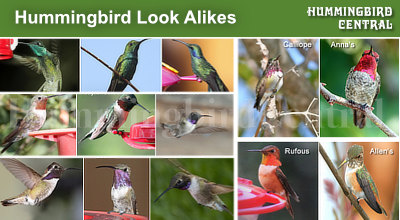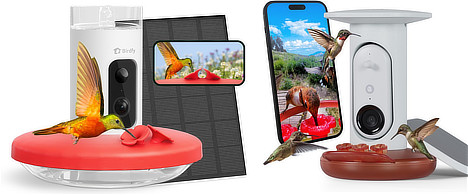Hummingbird Facts
The Hummingbird Family
Hummingbirds comprise the family Trochilidae, among the smallest of birds, with most species measuring in the 3"-5" range. They weigh only a few grams. They feature long slender needlelike bills adapted for reaching deep into tubular flowers to extract nectar.
These tiny birds can be found in North America, Central America, South America and many islands of the Caribbean Sea.
The Hummingbird Diet
Their diet consists of nectar from flowers (red is the favorite color), small insects such as aphids and spiders, and sometimes even pollen and sap.
Hummingbirds feed in many small meals, consuming small invertebrates and up to twelve times their own body weight in nectar each day.
Many plant species rely on hummingbirds for pollination and provide nectar and tiny insects in exchange. Hummingbirds staunchly and aggressively defend a feeding area, or feeder, even when not feeding.
Flying ... and Walking
The beat of their wings is so rapid, up to 55 times a second, that a "humming" sound is produced, and the wings appear blurred. They are the only bird species that can hover, and fly backwards, or even upside down. The ability to hover allows the hummingbirds to sip the nectar of plants and flowers.
A hummingbird can't walk or hop, but can shuffle with its extremely short legs, which are not very strong.
Research indicates a hummingbird can travel as much as 23 miles in one day. However, during migration as they cross the Gulf they may cover up to 500 miles at a time. Their average speed in direct flight is in the range of 20-30mph, and up to three times that fast during courtship dives.
Resting
Hummingbirds have the ability to go into a deep resting period, called "torpor", in which their respiration and heart rate become very slow. This can happen in cold weather, and the metabolic rate can drop to 1/5 of normal.
Talking and Communicating
 Cinnamon Hummingbird |
Hummingbirds have a variety of calls, chips, chatters and squeals to communicate with each other. Each species has its own "language" to alert other hummers or to challenge "invaders" of their feeding territories.
Life Expectancy of Hummingbirds
Hummingbirds, like all wildlife, can be victims of natural as well as man-made hazards.
Young hummingbirds must deal with rain, hail, cold weather, wind, snakes, squirrels, cats, dogs, ants and larger birds. And hummers have to navigate around houses, telephone poles, glass windows and buildings.
Plus, other man-made obstacles such as ecosystem destruction and the use of pesticides have a negative impact on hummingbird populations.
Many hummingbirds migrate in the spring, and again in the fall. Migration is always a challenge for hummingbirds, who must fly huge distances to live in an environment that is warm and has a plentiful food supply. Strong head winds, hurricanes, and cold fronts are difficult to fly through.
The average life span of a Ruby-Throated hummingbird is estimated by experts to be 3 - 5 years. Most deaths occur in the first year of life. The record age of a banded Ruby-Throated hummingbird is 6 years, 11 months.
Mating and Pairing
Hummingbirds do not "pair up" as do many birds, but instead the male and female go their own way after mating is complete. The male will move on to other females. The female is left with the job of building the nest, incubating the eggs and raising the young birds.
White Hummingbirds
Although somewhat rare in nature, there are indeed white hummingbirds! There are three types, a true Albino, and a Leucistic hummingbird ... and a mixture, known as Pied (or Piebald).
An albino hummingbird features white feathers along with pink eyes, bill and feet. These hummingbirds are very rare, and are the result of a genetic mutation that stops the creation of any dark pigment.
Read about Albino and white Leucistic Hummingbirds.
Hummingbird Nests and Eggs
A hummingbird's nest is very small, usually about 1.5" in diameter. Eggs are likewise small, less than 1" long, about the size of a jelly bean.
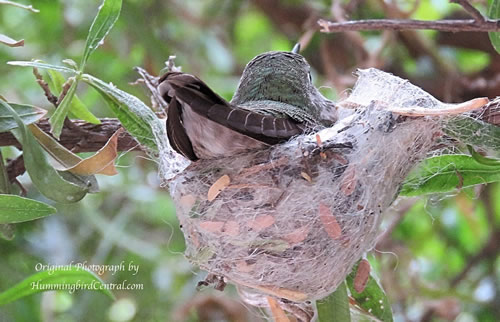 Hummingbird on nest (Photo courtesy of the author) |
The female lays her eggs on different days. The Ruby-Throated Hummingbird lays 2 eggs. Black-chinned Hummingbird, Anna's Hummingbird, Costa's Hummingbird, Calliope Hummingbird, Broad-tailed Hummingbird, Rufous Hummingbird and Allen's Hummingbird all lay 1-3 eggs. Gestation period is about 16-18 days.
Common Hummingbird Species in the U.S.
The hummingbird family is very large, with 366 species and 112 genera, according to the International Ornithologists' Union (IOU). Hummingbirds are found only in the Western Hemisphere, with almost half the species living in the "equatorial belt" between 10 degrees north and south of the equator. Fewer than two dozen species venture into the United States and Canada, and only a few species remain year-round.
Click here for an alphabetical list of all 366 species of hummingbirds (PDF)
This is a list of the 18 most common hummingbird species found in North America and featured on this website:
Common Name |
Scientific Name |
| Allen’s | Selasphorus sasin |
| Anna’s | Calypte anna |
| Berylline | Amazilia beryllina |
| Black-chinned | Archilochus alexandri |
| Blue-throated | Lampornis clemenciae |
| Broad-billed | Cynanthus latirostris |
| Broad-tailed | Selasphorus platycercus |
| Buff-bellied | Amazilia yucatanensis |
| Calliope | Stellula calliope |
| Costa’s | Calypte costae |
| Green-breasted Mango | Anthracothorax prevostii |
| Lucifer | Calothorax lucifer |
| Mexican Violetear | Colibri thalassinus |
| Rivoli's | Eugenes fulgens |
| Ruby-throated | Archilochus colubris |
| Rufous | Selasphorus rufus |
| Violet-crowned | Amazilia violiceps |
| White-eared | Hylocharis leucotis |
Where Are Hummingbirds Found?
In the Eastern and Central United States and Canada, the most common species is the Ruby-Throated hummingbird. Several species are in the Gulf region.
In the Western United States, one will often find Anna’s, Black-Chinned, Calliope, Broad-Tailed, Allen’s, White-eared, and Rufous hummingbirds. In Texas and the Southwestern United States, all species will be found from time to time.
Many other species are found in other countires ... read about the Hummingbirds in Central America and Hummingbirds in South America.
Hummingbird Species in Central American Countries |
||
| Country | Number of Species | Read More |
| Mexico | 58 | Hummingbirds of Mexico |
| Guatemala | 39 | Hummingbirds of Guatemala |
| Belize | 26 | Hummingbirds of Belize |
| Honduras | 42 | Hummingbirds of Honduras |
| El Salvador | 23 | Hummingbirds of El Salvador |
| Nicaragua | 34 | Hummingbirds of Nicaragua |
| Costa Rica | 54 | Hummingbirds of Costa Rica |
| Panama | 59 | Hummingbirds of Panama |
Hummingbird Species in South American Countries |
||
| Country | Number of Species | Read More |
| Colombia | 165 | Hummingbirds of Colombia |
| Ecuador | 132 | Hummingbirds of Ecuador |
| Peru | 124 | Hummingbirds of Peru |
| Venezuela | 100 | Hummingbirds of Venezula |
| Bolivia | 83 | Hummingbirds of Bolivia |
| Brazil | 81 | Hummingbirds of Brazil |
| Guyana | 39 | |
| Argentina | 36 | |
| Suriname | 35 | |
| French Guyana | 32 | |
| Paraguay | 20 | |
| Chile | 10 | |
| Uruguay | 6 | |
Hummingbird Populations in the United States and Canada
The most common species is the Ruby-throated, with an estimated population of 34,000,000. There are an estimated 19,000,000 Rufous Hummingbirds, and 8,200,000 Anna's. Read more about hummingbird populations
Ruby-throated Hummingbird
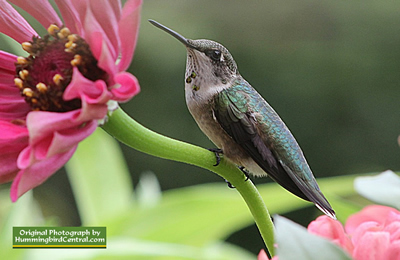 |
The Ruby-throated Hummingbird is the only species regularly seen over most the eastern United States. Ruby-throats are the only hummingbird found east of the Great Plains, except for the Rufous.
It is about 3 3/4" in length, and metallic green above. Its notes are a rapid, high-pitched squeaky, chipping sound.
The adult male has a brilliant ruby red throat (gorget), black chin, and deeply notched, forked tail.
The female's throat is white, and immatures are similar in color to the female. The female body is slender, with a blunt, rounded tail with white corners. The female Ruby-throated and Black-chinned are very similar, but have separate ranges. Males use a repeating "pendulum" arch of flight to attract females.
Ruby-throated Hummingbird Video
The Ruby-throated is the only hummingbird found consistently all over the Eastern U.S. and Canada.
The average life span is estimated by experts to be 3 - 5 years. The record age of a banded ruby-throated hummingbird is 6 years, 11 months. The average length is 3 3/4".
This video features information about the Ruby-throat, including photos, quick facts and migration patterns. It runs only about 3 minutes and features some easy listening music, so turn up your volume and meet the Ruby-throated hummingbird!
Hummingbird Predators
Full-grown hummingbirds can fall victim to a number of predators including cats, and birds such as hawks, kestrels, shrikes, roadrunners, and kites. Even bees and wasps can fatally sting a hummingbird. Hummingbird eggs or fledglings in a nest can be victims of nest-robbers like bluejays, crows, squirrels, snakes, and raccoons.
Hummingbirds can also get caught in spider webs when seeking silk for nesting material.
Many people ask ... "Can a Praying Mantis eat a hummingbird?" ... the answer is "Yes". We have seen it happen on a feeder, and it isn't a pretty sight. As difficult as it might be to imagine, "Mantids" can sometimes capture, kill, and eat a hummingbird. The quick strike of the mantid, on a plant or feeder, can immobilize a hummingbird.
And of course there are always those "window strikes" that happen when fast moving hummingbirds fly into windows ... our experience is that probably 95% of these strikes are NOT fatal, with the hummer bouncing off and flying off unhurt. Many bird watchers place colorful stickers on their windows to alleviate strikes.
Many people like us have screen porches. Our porch juts out from the house, and hummers sometimes fly into the screen ... but 98% of the time they just reverse direction, and back out with no problem. Only a couple times in 15 years have we had to gently nudge their beak and help them back out!
Popular Hummingbird Feeders This Year
|
||
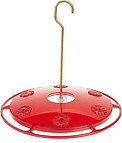 Aspects HummZinger Excel Hanging Hummingbird Feeder with Built-in Ant Moat |
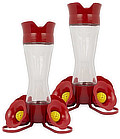 Pinched glass Hummingbird Feeder with built-in ant moat, pack of two feeders |
|
 Colorful hand-blown glass Hummingbird Feeder, 32oz, with Ant Moat, Hanging Hook, Rope, & Brush |
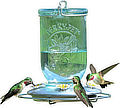 Perky-Pet 785-1SR Mason Jar Vintage Glass Hummingbird Feeder - 32oz Nectar Capacity |
|
 Mini Hummingbird Feeder with single flower, 4-Pack, 2.3oz |
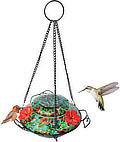 Nature's Way Glass Top-Fill Hanging Hummingbird Feeder |
|
Different designs, features and manufacterers are available to choose from based on the user's preferences and needs. Choose from one or dual cameras, various BlueTooth and WiFi options, video quality, solar power, notifications, night vision and other options. Popular brands include Birfy, Birdbuddy and others. Click below to view various feeders at Amazon. |
||
|
||
 |
| About These Products
The Hummingbird Central website is a participant in the Amazon Services LLC Associates Program, an affiliate advertising program designed to provide a means for sites to earn fees by advertising and linking to Amazon.com and affiliated sites. Amazon offers a commission on products sold through their affiliate links. There is no additional cost to you. Order processing and shipping is done by Amazon. |
Hummingbird Central Showcase
We've developed a short YouTube video featuring the hummingbird species found in the United States and Canada.
It also includes some charts comparing similiar species and has a special section dealing with white and albino hummingbirds.
It runs for about 6 minutes, and has soft music to accompany it ... take a look, at the Hummingbird Showcase



